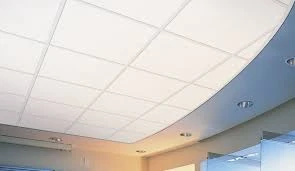Dec . 07, 2024 16:58 Back to list
suspended mineral fibre ceiling
The Importance of Suspended Mineral Fibre Ceiling in Modern Architecture
In the realm of contemporary architecture and interior design, suspended mineral fibre ceilings have emerged as a popular choice for both residential and commercial spaces. These ceilings, also known as acoustic ceiling tiles, offer a unique blend of aesthetics, functionality, and practicality, making them an indispensable element in modern construction.
What Are Suspended Mineral Fibre Ceilings?
Suspended mineral fibre ceilings are composed of a variety of materials, primarily mineral wool, which is known for its excellent acoustic and thermal properties. These ceilings are installed beneath the structural ceiling, creating a cavity of air that can conceal electrical wiring, plumbing, and HVAC systems. The tiles typically come in standard grid patterns, making installation straightforward and efficient.
Acoustic Benefits
One of the standout features of suspended mineral fibre ceilings is their exceptional sound-absorbing capabilities. In open spaces such as offices, schools, and healthcare facilities, noise control can significantly enhance productivity and comfort. These ceilings can reduce echo and background noise, creating a quieter environment conducive to focus and communication. In educational settings, for example, reduced noise levels allow students to concentrate better, leading to improved learning outcomes.
Thermal Insulation
In addition to sound absorption, suspended mineral fibre ceilings also provide thermal insulation. They help regulate indoor temperatures by reflecting heat in summer and retaining warmth in winter. This characteristic not only enhances comfort but also contributes to energy efficiency. Buildings with better insulation can see reduced energy costs, making them both environmentally friendly and economical.
Aesthetic Versatility
suspended mineral fibre ceiling

Suspended mineral fibre ceilings come in a variety of styles, colors, and textures, allowing designers to create visually appealing spaces. From sleek modern designs to more traditional finishes, the aesthetic versatility of these ceilings enables architects and interior designers to align them with the overall vision of a project. They can be combined with recessed lighting fixtures and other design elements to enhance the ambiance and functionality of a room.
Fire Resistance and Safety
Another significant advantage of suspended mineral fibre ceilings is their fire-resistant properties. Many mineral fibre ceiling tiles are manufactured with fire-retardant materials, making them a safer choice for commercial buildings and public spaces. In the event of a fire, these ceilings can help slow down the spread of flames and smoke, providing crucial extra time for evacuation and potentially saving lives.
Ease of Maintenance
Maintaining suspended mineral fibre ceilings is relatively straightforward. The tiles can be easily removed for access to the space above the ceiling, allowing for simple repairs or upgrades without extensive demolition. Regular cleaning can also help retain their aesthetic appeal and performance, making these ceilings a practical choice for busy environments.
Sustainability
With an increased emphasis on sustainability in construction, many manufacturers produce mineral fibre ceilings from recycled materials. This aligns with green building practices and helps organizations meet environmental standards and certifications. Choosing suspended mineral fibre ceilings can contribute to a building's overall sustainability profile.
Conclusion
Suspended mineral fibre ceilings represent an essential component in modern architecture. Their combination of acoustic and thermal insulation, aesthetic versatility, fire resistance, ease of maintenance, and sustainability make them an attractive option for a wide range of applications. As architects and designers continue to prioritize comfort, safety, and environmental responsibility, the demand for such ceilings is likely to grow. Investing in suspended mineral fibre ceilings not only enhances the quality of indoor environments but also contributes to a more sustainable future in construction and design. Whether in a bustling office, an educational facility, or a residential space, these ceilings play a vital role in shaping the way we experience our surroundings.
-
Quality Ceiling Trap Doors & Access Panels | Easy & Secure AccessNewsAug.30,2025
-
Durable Ceiling T Grid Systems | Easy InstallationNewsAug.29,2025
-
PVC Gypsum Ceiling: Durable, Laminated Tiles for Modern SpacesNewsAug.28,2025
-
Pvc Gypsum Ceiling Is DurableNewsAug.21,2025
-
Mineral Fiber Board Is DurableNewsAug.21,2025
-
Ceiling Tile Clip Reusable DesignNewsAug.21,2025







